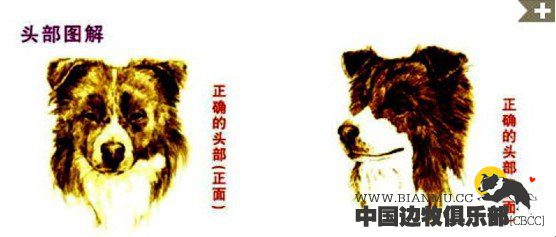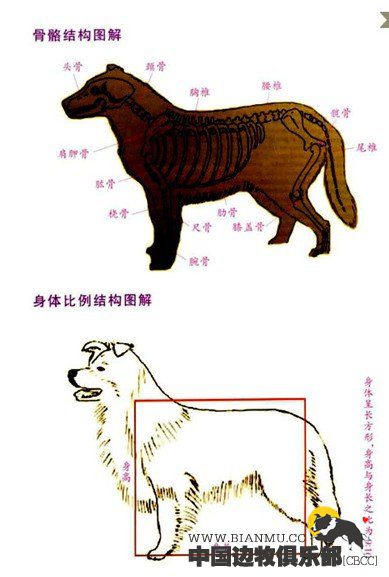边境牧羊犬 FCI标准 (图文并茂)
尺寸:中
寿命:10-14年
运动:非常高
美容:中
可训练性:非常高
看门狗能力:高
防护能力:中
地区:苏格兰与英格兰边界
地日期:1800年
其他名称:无
原有的功能:牧羊特性:
边境牧羊犬是非常聪明的,一种本能的倾向,工作是容易的训练。它的敏锐,警觉,并渴望表达增加其智能的外观,而其忠诚度和忠实的性质表明,它是在任何时候都仁慈地对待股票。结构或气质外的任何方面工作犬是不寻常的。
一般外观:
一般外观应是非常匀称的狗,平滑的轮廓展现高品质,优雅和完美的平衡,有足够的物质相结合,以确保它能够承受长时间的活动在其预定的任务作为工作牧羊犬。任何粗糙或杂草的倾向是不可取的。
总目:
头骨宽阔平坦,两耳间的小幅收窄的眼睛,一个显着的止的脸颊深,但不突出。口吻,逐渐变细的鼻子,是强大的和相同长度的头骨。嘴唇是紧张的,干净,
鼻子大,鼻孔张开。在所有的狗的鼻子颜色是纯色,没有粉红色的或浅色素,并应赞扬的背景颜色的狗。



耳朵:
耳朵应该是中等大小,质地,自然分开,进行半直立(半直立就是1/2折耳)和敏感的,在使用内设备齐全的头发。

口:
牙齿应该是完善的,强大的和均匀分布的,下门牙的后面,但摸上,这是一个剪状咬合。..

颈部:
颈部有足够的长度,结实,肌肉发达,略拱,扩大到肩膀,没有赘肉或粗糙。
前躯:
很长,肩膀以及角度,上臂,既不内翻也不在肘部。从前面看,前腿时,骨量充足,直,彼此平行。脚腕的灵活性,从侧面观察时,一个轻微的倾斜。

内容:
身体是中等长度,肋骨逐渐变细到一个相当深,宽度适中的胸部..腰部宽,深,肌肉发达,以及打开膝关节和强大的飞节,让下来,并从后面观察时,直且平行..



后躯:
后躯宽而肌肉发达,轮廓优雅倾斜的尾巴上设置。大腿长,宽,深,肌肉发达,以及打开膝关节和跗关节,以及辜负强,从后面观察时,直且平行。

椭圆形,脚垫深,强大而完善,脚趾适度圆拱且紧密结合在一起。指甲短而结实。
 尾巴:
尾巴:尾巴:中等长度,设定为低,配有一个向上的涡流接近尾声,完成了优美的轮廓和平衡的狗。尾巴会中提出的兴奋,但没有在后面进行。

运动:
运动是自由的,光滑而不倦,与所谓的最小提升的脚,传达的移动能力非常隐形的印象。行动,从正面看,应该是直线前进,并真实,肩,肘或骹骨毫不示弱。从后面宿舍的强度和柔韧性的推力,飞节不近也相距甚远。小跑时,狗的脚往往紧密联系起来,随着速度的增加,但当狗来休息时,他应该站在四方形。任何倾向stiltiness或牛肢或bowhocks是一个严重的错误。

被毛:
双涂层,而一个中等长度,浓密,中等纹理面漆的底毛短,柔软,浓密,一个耐候保护与丰富的大衣形成的鬃毛,臀部和刷。于脸部,耳尖,前肢(除了羽毛),后肢飞节到地面,头发短而平滑。平滑的皮毛上是可以接受的。

颜色:
有多种颜色是允许的,但白色不应该占主导地位。

大小:
身高:雄性48-53厘米(约19-21)马肩隆处
母犬肩高46-51厘米(约18-20)
缺点:
任何偏离上述各点应被认为是一个错误,应该是在精确的比例,其程度严重的故障。
注:
雄性动物应该有两个明显的睾丸下降到阴囊。
边境牧羊犬(Border Collie)FCI标准(英文版)
Border Collie
Working
Group: Working
Size: medium
Lifespan: 10-14 years
Exercise: very high
Grooming: medium
Trainability: very high
Watchdog ability: high
Protection ability: medium
Area of Origin: border of Scotland and England
Date of Origin: 1800’s
Other Names: none
Original Function: sheep herding
CHARACTERISTICS:
The Border Collie is highly intelligent, with an instinctive tendency to work and is readily responsive to training. It's keen, alert and eager expression add to its intelligent appearance, whilst its loyalty and faithful nature demonstrates that it is at all times kindly disposed towards stock. Any aspect of structure or temperament foreign to a working dog is uncharacteristic.
GENERAL APPEARANCE:
The general appearance should be that of a well proportioned dog, the smooth outline showing quality, gracefulness and perfect balance, combined with sufficient substance to ensure that it is capable of enduring long periods of activity in its intended task as a working sheepdog. Any tendency to coarseness or weediness is undesirable.
Head:
The skull is broad and flat between the ears, slightly narrowing to the eye with a pronounced stop cheeks deep but not prominent. The muzzle, tapering to the nose, is strong and the same length as the skull. The lips are tight and clean and the nose is large with open nostrils. The nose colour in all dogs will be a solid colour with no pink or light pigment, and shall compliment the backgrounds colour of the dog .
Eyes:
The eyes are set wide apart, oval shaped of moderate size harmonising with the colour of the coat but darker colour preferred, except in the case of chocolate where a lighter colour is permissable and in the case of merles where blue is permissable. The expression is mild but keen, alert and intelligent.
Ears:
The ears should be of medium size and texture, set well apart, carried semi-erect and sensitive in their use and inside well furnished with hair.
Mouth:
The teeth should be sound, strong and evenly spaced, the lower incisors just behind but touching the upper, that is a scissor bite..
Neck:
The neck is of good length, strong and muscular, slightly arched and broadening to the shoulders, without throatiness or coarseness.
Forequarters:
The shoulders are long and well angulated to the upper arm, neither in nor out at the elbow. The forelegs are well boned, straight and parallel when viewed from the front. Pasterns show flexibility with a slight slope when viewed from the side.
Body:
The body is moderately long with well-sprung ribs tapering to a fairly deep and moderately broad chest.. The loins are broad, deep and muscular with well turned stifles and strong hocks, well let down, and when viewed from the rear are straight and parallel..
Hindquarters:
The hindquarters are broad and muscular, in profile sloping gracefully to the set on of the tail. The thighs are long, broad, deep, muscular with well turned stifles and strong hocks, well let down, and when viewed from the rear are straight and parallel.
Feet:
Oval in shape, pads deep, strong and sound, toes moderately arched and close together. Nails short and strong.
Tail:
The tail is moderately long, set on low, well furnished with an upward swirl towards the end, completing the graceful contour and balance of the dog. The tail may be raised in excitement but not carried over the back.
Movement:
The movement is free, smooth and tireless, with a minimum lift of the feet, conveying the impression of the ability to move with great stealth. The action, viewed from the front, should be straight forward and true, without weakness at shoulders, elbows or pasterns. Viewed from behind the quarters thrust with strength and flexibility, with hocks not close nor too far apart. When trotting, the dog's feet tend to come closer together as speed increases, but when the dog comes to rest he should stand four square. Any tendency to stiltiness or to cowhocks or bowhocks is a serious fault.
Coat:
Double coated, with a moderately long, dense, medium textured topcoat while the undercoat is short, soft and dense, making a weather resisting protection with an abundant coat to form a mane, breeching and brush. On face, ear tips, forelegs (except for feather), hindlegs from hock to ground, the hair is short and smooth. A smooth coat is acceptable.
Colour:
A variety of colours is permissible, but white should never predominate.
Size:
Height: Dogs 48-53 cm (approx 19-21 in) at withers
Bitches 46-51 cm (approx. 18-20 in) at withers
Faults:
Any departure from the foregoing points should be considered a fault and the seriousness of the fault should be in exact proportion to its degree.
Note:
Male animals should have two apparently normal testicles fully descended into the scrotum.